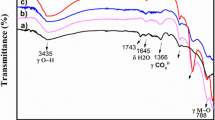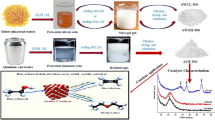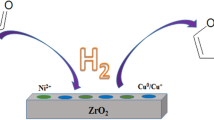Abstract
Three methods of introduction of modifiers based on Cu and Zn compounds into the CrOx/Al2O3 catalysts for dehydrogenation of light paraffin hydrocarbons are considered: Introduction from sol, introduction using successive impregnation technique and introduction of modifiers by impregnation along with precursor of chromium oxide. The obtained samples are studied by a complex of physical-chemical methods (XRD, UV-Vis spectroscopy, temperature-programmed reduction with hydrogen (TPR-H2), X-ray fluorescent (XRF) spectrometry, low-temperature N2 sorption). The catalytic properties of the samples are studied in kinetic mode in isobutane dehydrogenation. Cu- and Zn-modifiers are shown to influence on the peculiarities of reduction of Cr6+ and, hence, specify the state of active surface of CrOx/Al2O3 catalysts formed in the reductive reaction medium. Not only do the states of modifiers influence on the initial activity of the catalyst, but also on its activity after oxidative regeneration. Introduction of modifiers by successive impregnation method results in formation of copper and zinc aluminates or defective spinels on the Al2O3 surface. When the active component is introduced, the modified surface of the support promotes formation and stabilization of Cr6+ sites that can undergo reversible reduction–oxidation and provide high activity and selectivity towards formation of isobutylene (>98%).
Similar content being viewed by others
References
Sattler, J.J.H.B., Ruiz-Martinez, J., Santillan-Jimenez, E., and Weckhuysen, B.M., Chem. Rev., 2014, vol. 114, p. 10613.
Sanz, S.G., McMillan, L., McGregor, J., Zeitler, J.A., Al-Yassir, N., Al-Khattaf, S., and Gladden, L.F., Catal. Sci. Technol., 2016, vol. 6, p. 1120.
Pakhomov, A.N., Nauchnye Osnovy prigotovleniya katalizatorov: vvedenie v teoriyu i praktiku (Scientific features of catalysts preparation: introduction to theory and practice), Izd-vo SO RAN, 2011, p.262.
Tyuryaev, I.Ya., Teoreticheskie osnovy polucheniya butadiena i izoprena metodami degidrirovaniya (Theoretical fundamentals of butadiene and isoprene synthesis by dehydrogenation), Kiev: Naukova Dumka, 1973.
Rubinstein, A.M., Pribytkova, N.A., Afanas’ev, V.A., and Slinkin, A.A., Actes 2-me Congr. Int. Catal. P.: Technip., 1961, vol. 2, p. 1981.
Carra, S. and Forni, L., Catal. Rev.: Sci. and Eng., 1972, p.159.
Kotel’nikov, G.R., Strunnikova, A.V., Patanov, V.A., and Arapova, I.P., Katalizatory degidrirovaniya nizshikh parafinovykh, olefinovykh i alkilaromaticheskikh uglevodorodov (Catalysts for the dehydrogenation of lower paraffinic, olefinic and alkylaromatic hydrocarbons), Moscow: TsNIITEneftekhim, 1978.
Shee, D. and Sayari, A., Appl. Catal., A, 2010, vol. 389, p.155.
Yang, X., Sol–gel synthesized nanomaterials for environmental applications, PhD-thesis K. K-State, 2008, p.177.
Xu, L., Wang, Z., Song, H., and Chou, L., Catal. Commun., 2013, vol. 35, p.76.
Zhao, H., Song, H., Xu, L., and Chou, L., Appl. Catal., A, 2013, vol. 456, p.188.
Lebedev, N.N., Khimiya i tekhnologiya osnovnogo organicheskogo i neftekhimicheskogo sinteza (Chemistry and technology of basic organic and non-petrochemical synthetics), Moscow: Khimiya, 1981.
Rombi, E., Cutrufello, M.G., Solinas, V., De Rossi, S., Ferraris, G., and Pistone, A., Appl. Catal., A, 2003, p.255.
Neri, G., Pistone, A., De Rossi, S., Rombi, E., Milone, C., and Galvagno, S., Appl. Catal., A, 2004, vol. 260, p.75.
Beccari, M. and Romano, U., Encyclopaedia of hydrocarbons, Rome: ENI & Istituto della Enciclopedia Italiana G. Treccani, 2006, vol. 2, p.687.
RF Patent 2176157, 2001.
US Patent 6362385 B1, 2002.
US Patent 20050075243 A1, 2005.
RF Patent 2325227, 2008.
RF Patent 2448770, 2012.
Bahmani, M., Farahani, B.V., and Sahebdelfar, S., Appl. Catal., A, 2016, vol. 520, p. 178
Sameh, M.K., Aboul-fotouh, Fuel Chem. Technol., 2014, vol. 42, p.350.
Debecker, D.P., Stoyanova, M., Colbeau-Justin, F., Rodemerck, U., Boissire, C., Gaigneaux, E.M., and Sanchez, C., Angew. Chem., 2012, vol. 51, p. 2129.
Kirszensztejn, P. and Przekop, R., Annales UMCS, Chemia, 2011, vol. 66, p.12.
Takeishi, K. and Akaike, Y., Appl. Catal., A, 2016, vol. 510, p.20.
Bugrova, T.A., Litvyakova, N.N., and Mamontov, G.V., Kinet. Catal., 2015, vol. 56, issue 6, p.758.
Kim, T.-W., Song, M.-W., Koh, H.-L., and Kim, K.-L., Appl. Catal., A, 2001, vol. 210, p.35.
Weckhusen, B.M., Verberckmoes, An.A., De Baets, A.R., and Schoonheydt, R.A., J. Catal., 1997, vol. 166, p.160.
Cavani, F., Koutyrev, M., Trifiro, F., Bartolini, A., Ghisletti, D., Iezzi, R., Santucci, A., and Del Piero, G., J. Catal., 1996, vol. 158, p.236.
Cutrufello, M.G., De Rossi, S., Ferino, I., et al., Thermochim. Acta, 2005, vol. 434, p.62.
Yamamoto, T., Tanaka, T., Kuma, R., Suzuki, S., Amano, F., Shimooka, Y., Kohno, Y., Funabika, T., and Yoshida, S., Phys. Chem. Chem. Phys., 2002, vol. 4, p. 2449.
Smith, M.L., Campos, A., and Spivey, J., Catal. Today, 2012, vol. 182, p.60.
Fridman, V.Z., Xing, R., and Severance, M., Appl. Catal., A, 2016, vol. 523, p.39.
Luo, M.-F., Fang, P., He, M., and Xie, Y. -L, J. Mol. Catal. A: Chem., 2005, vol. 239, p.243.
Zhu, H., Dong, X., Shi, L., and Sun, Q., J. Nat. Gas Chem., 2010, vol. 19, p.67.
Maniecki, T.P., Mierczynski, P., and Jozwiak, W.K., Kinet. Catal., 2010, vol. 51, p.843.
Sattler, J.J.H.B., Mens, A.M., and Weckhuysen, B.M., ChemCatChem, 2014, vol. 6, p. 3139.
Author information
Authors and Affiliations
Corresponding author
Additional information
Original Russian Text © A.A. Merk, M.A. Salaev, O.V. Vodyankina, G.V. Mamontov, 2018, published in Kinetika i Kataliz, 2018, Vol. 59, No. 2, pp. 232–239.
The article was translated by the authors.
Rights and permissions
About this article
Cite this article
Merk, A.A., Salaev, M.A., Vodyankina, O.V. et al. Influence of Method of Introduction of Cu- and Zn-Based Modifiers on the Properties of Chromia–Alumina Catalysts. Kinet Catal 59, 211–217 (2018). https://doi.org/10.1134/S0023158418020118
Received:
Published:
Issue Date:
DOI: https://doi.org/10.1134/S0023158418020118




